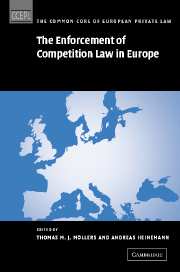Book contents
- Frontmatter
- Contents
- Preface
- Contributors to the volume
- Abbreviations (including legislation)
- Introduction
- Part I Remedies in Unfair Competition and Consumer Protection Law
- A Setting the basics – the legal framework
- B Contemporary solutions: the case studies
- C Results and conclusions for remedies in unfair competition law
- D Graphics
- Part II Remedies in Antitrust Law
- Outlook: the link between unfair competition law and antitrust law
- Bibliography
- General index
- Index by state
B - Contemporary solutions: the case studies
Published online by Cambridge University Press: 29 June 2009
- Frontmatter
- Contents
- Preface
- Contributors to the volume
- Abbreviations (including legislation)
- Introduction
- Part I Remedies in Unfair Competition and Consumer Protection Law
- A Setting the basics – the legal framework
- B Contemporary solutions: the case studies
- C Results and conclusions for remedies in unfair competition law
- D Graphics
- Part II Remedies in Antitrust Law
- Outlook: the link between unfair competition law and antitrust law
- Bibliography
- General index
- Index by state
Summary
Objects of claim – the sanctions
Case 1 Risky bread: order to cease and desist, elimination, publication
A is a baker. He advertises his products as being particularly environmentally friendly. At the same time he claims that his competitor B sells bread with additional ingredients whose risks have not yet been analysed sufficiently. Therefore, it would be very risky to eat the bread offered by B. A has also printed advertisements stating these claims.
In which way can one prevent A from publishing this misleading advertisement in the future?
Austria (1)
Assuming that the risks posed by the additional ingredients used by B cannot be proven, A's advertisement is a depreciatory comparative advertisement since A combined his allegations with the advertisement for his own product, allegedly particularly free from harmful substances. This advertisement can also be misleading, if A's bread is actually free from harmful substances in order to comply with law relating to food and drugs. If this is the case, it would be an advertisement stating obvious facts. Where comparative advertisement is concerned the advertiser bears the burden of proof for the statements of fact contained in the advertisement (§ 2 para. 5 UWG). This is congruent with the burden of proof in § 7 UWG: the plaintiff only has to prove the allegation (circulation) of the harmful facts, whereas the defendant – comparable to § 111 f StGB – has to prove the truth of his allegations.
- Type
- Chapter
- Information
- The Enforcement of Competition Law in Europe , pp. 89 - 358Publisher: Cambridge University PressPrint publication year: 2008



